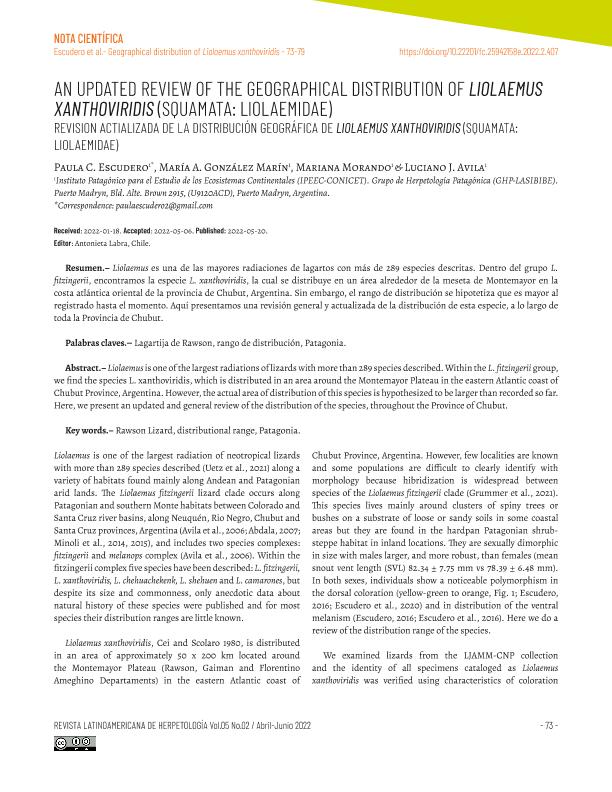Artículo
Liolaemus es una de las mayores radiaciones de lagartos con más de 289 especies descritas. Dentro del grupo L. fitzingerii, encontramos la especie L. xanthoviridis, la cual se distribuye en un área alrededor de la meseta de Montemayor en la costa atlántica oriental de la provincia de Chubut, Argentina. Sin embargo, el rango de distribución se hipotetiza que es mayor al registrado hasta el momento. Aquí presentamos una revisión general y actualizada de la distribución de esta especie, a lo largo de toda la Provincia de Chubut. Liolaemus is one of the largest radiations of lizards with more than 289 species described. Within the L. fitzingerii group, we find the species L. xanthoviridis, which is distributed in an area around the Montemayor Plateau in the eastern Atlantic coast of Chubut Province, Argentina. However, the actual area of distribution of this species is hypothesized to be larger than recorded so far. Here, we present an updated and general review of the distribution of the species, throughout the Province of Chubut.
An updated review of the geographical distribution of Liolaemus xanthoviridis (Squamata: Liolaemidae)
Título:
Revisión actualizada de la distribución geográfica de Liolaemus xanthoviridis (Squamata:Liolaemidae)
Fecha de publicación:
20/05/2022
Editorial:
Sociedad Herpetologica Mexicana
Revista:
Revista Latinoamericana de Herpetologia
ISSN:
2594-2158
Idioma:
Inglés
Tipo de recurso:
Artículo publicado
Clasificación temática:
Resumen
Palabras clave:
RAWSON LIZARD
,
DSTRIBUTION RANGE
,
PATAGONIA
Archivos asociados
Licencia
Identificadores
Colecciones
Articulos(IPEEC)
Articulos de INSTITUTO PATAGONICO PARA EL ESTUDIO DE LOS ECOSISTEMAS CONTINENTALES
Articulos de INSTITUTO PATAGONICO PARA EL ESTUDIO DE LOS ECOSISTEMAS CONTINENTALES
Citación
Escudero, Paula Cecilia; Gonzalez Marin, Maria Andrea; Morando, Mariana; Avila, Luciano Javier; An updated review of the geographical distribution of Liolaemus xanthoviridis (Squamata: Liolaemidae); Sociedad Herpetologica Mexicana; Revista Latinoamericana de Herpetologia; 5; 2; 20-5-2022; 73-79
Compartir




